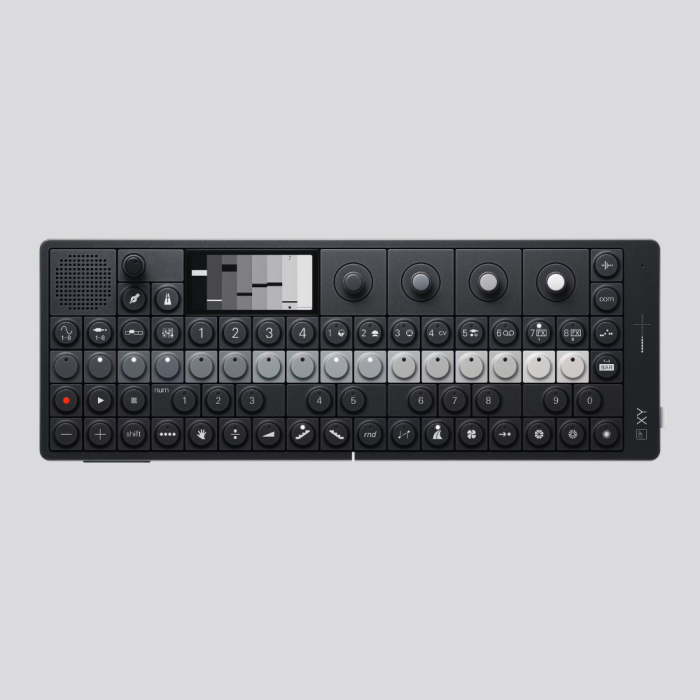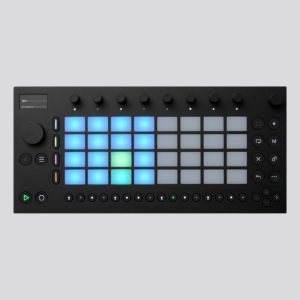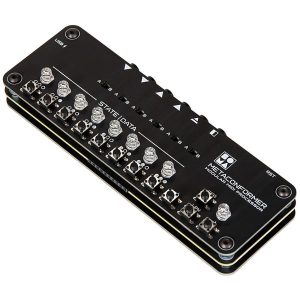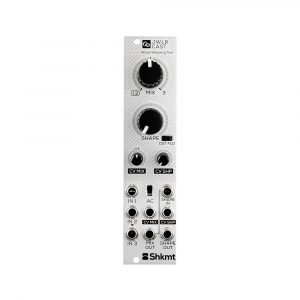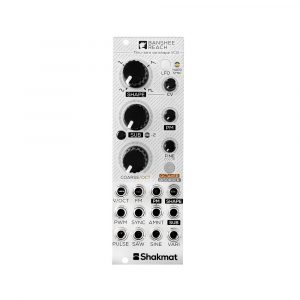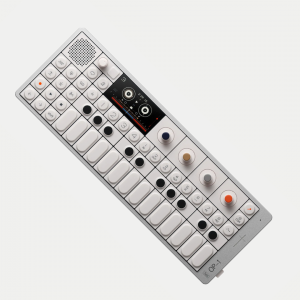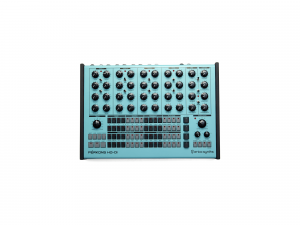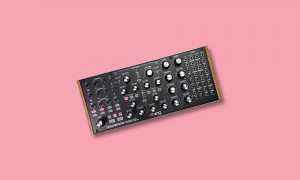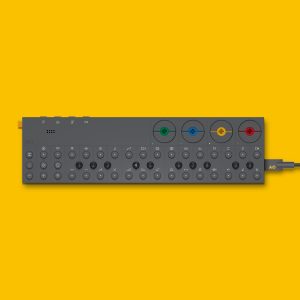Sequences all the way down: Teenage Engineering‘s most ambitious instrument to date is a Russian doll of rhythm and sound.
Though now dressed in all black, Teenage Engineering’s latest creation, the OP-XY, feels like a fusion of the best ideas from the various machines the company has developed before it. Fundamentally, it combines the powerful sequencer of the OP-Z with the robust industrial design, high-fidelity DSP, and general layout of the OP-1 field, while adding a vast range of new features—from both the rest of the TE pack and further afield. In sum, the Stockholm-based company has delivered a fresh and wildly capable tool that’s creatively rewarding to use.
The OP-XY’s design language continues the sensibility of Teenage Engineering’s other products, most notably the OP-1 field. Like the field, it is fully portable, thanks to a crisp built-in speaker and battery that will last you some 15 hours on a charge. It swaps their more traditional use of spot color for a monochrome palette enhanced with gradients, resulting in a sort of Braun-inspired, “playful brutalism” aesthetic. The layout is clean and intuitive, with a thoughtful arrangement of controls that prioritizes ease of use while maintaining aesthetic equilibrium. The OLED’s on-screen graphics are a masterclass in functional minimalism, balancing clarity with subtle depth. Red accents are used sparingly to highlight key actions or statuses (i.e. recording, selected modes, and active parameters), creating a focal point without overwhelming the display. The clean typography and playful, sharp graphic iconography align perfectly with the hardware aesthetic.
Unlike the OP-Z, where all tracks are lumped together, projects on the Teenage Engineering OP-XY are broken up into instrument tracks and auxiliary tracks. Each of the eight instrument tracks can accommodate any of the device’s range of synths and samplers (more on those in a bit), and this is where you build your melodies and rhythms. The eight auxiliary tracks, meanwhile, are where much of the device’s unique magic happens. These include two effects tracks (each offering six effect types), as well as I/O tracks for audio input, MIDI and CV sequencing. There are tracks for real-time performance punch-in effects and tape effects, respectively (and you can also apply punch-in effects to tracks individually). Finally, the Brain track is used for changing scales and automatic key signatures across all of the instrument tracks.
Those last three in particular are sources of great power. The punch-in track allows for real-time MIDI and audio effects, transforming existing sequences with a high degree of spontaneity. The effects range from subtle modulations to extreme sonic grafts—glitchy stutters that fragment rhythmic patterns, sweeping filters that can morph sounds from crisp and defined to expansive and ethereal, momentary randomizers and complex mixing processes. The tape track brings another layer of experimental potential, functioning like a virtualized tape machine with capabilities that blur the lines between recording, manipulation, and performance. Audio can be stretched, compressed, and warped in ways that evoke vintage sampling techniques, while simultaneously pushing beyond analog limitations. Pitch shifts create dramatic transformations, time-warping allows for non-linear sound exploration, and the inherent lo-fi character introduces textural complexity that feels both nostalgic and cutting-edge.
Finally, the Brain track lets you establish complex harmonic frameworks and key/transposition changes across all of your tracks with unprecedented ease, and proves itself an excellent tool for coming up with unexpected melodic ideas and chord changes, As on the OP-Z, all of these performance effects can themselves be sequenced in patterns of up to 64 steps, which allows for the building of incredibly dynamic compositions.
Also carried over from the OP-Z, step components are a cornerstone of the OP-XY’s sequencing power, providing endless ways to add depth and variation to your compositions. Essentially, you’re able to assign conditional triggers to individual steps, ensuring that certain operations only play under specific circumstances, such as after a set number of repetitions or when other conditions are met. This feature allows you to create extremely dynamic, evolving patterns that go far beyond linear step sequencing; apply a ratchet, a jump to another step, or an alternate note—either every time that step plays, or after a selected number of bars. Parameter locking, meanwhile, lets you alter multiple sound parameters —filter cutoff, pitch, or reverb amount, for instance—on a per-step basis within a single sequence, enabling dramatic shifts and intricate detail. By combining all of these tools, it’s easy to transform extremely basic loops into complex, evolving compositions that constantly reveal happy accidents.
Indeed, these interconnected features represent more than technical innovations—they’re conceptual bridges between precise electronic music production and the unpredictable, organic nature of live performance. Each offers a different philosophical approach to sound manipulation, inviting the user to reconsider the boundaries between composition, performance and sound design. This elevates the OP-XY beyond a standard multitrack sequencer, letting the user sequence their sequences in incredibly elaborate and powerful ways. The degree of meta sequencing—sequencers within sequencers within sequencers—feels genuinely new and novel, and is complimented by an interface that makes it easy to locate yourself inside its labyrinth of Matryoshka stacking dolls.
In terms of sound design, the Teenage Engineering OP-XY is equipped with eight unique synth engines, a drum sampler, and a multisampler, each offering distinct sound-shaping capabilities. The synth engines include Dissolve, which generates tonal noise for creating ambient pads and noisy leads, and Swarm, which modulates oscillators with noise for dense, textured soundscapes. AM and FM engines focus on amplitude and frequency modulation, respectively, adding depth and tonal complexity to your sound design. Detune subtly alters the pitch of each oscillator, resulting in rich, layered sounds great for atmospheric compositions. On the sampler side, the OP-XY includes a one-shot sampler, which allows you to capture, pitch, and save individual sound samples with ease. The multisampler takes things further, enabling you to grab multiple samples from an instrument and apply pitch and time-stretching to craft expressive, playable patches. (Sampling can be done using the built-in microphone, line-in or USB-C.) With 24-voice multitimbral synthesis and four versatile filter types, the OP-XY provides a robust toolkit for sound design.
Filling a project with eight tracks of instrument sequences—each consisting of up to four pages with 64 steps per page—is remarkably fast and intuitive. Simply select an instrument channel, and either input notes or samples directly onto a step, or record your playing in live. While you’ll typically be modifying presets rather than building patches from scratch, it’s easy to get great sounds out of the OP-XY. Beyond the standard sampler, you’ll find a multisampling feature that lets you map different samples across the keyboard. Instead of simply pitching one sample up and down, you can use separate recordings for different ranges—creating much more realistic and expressive-sounding patches.
While it definitely excels as a self-contained portable studio, the Teenage Engineering OP-XY also features MIDI and CV connectivity via its innovative multimode ⅛” output jack, making it easy to integrate into a larger setup. Whether you’re controlling a modular voice or simply syncing with other hardware, this flexibility ensures that it’s not just a standalone tool but also a valuable addition to a studio or live rig.
All of this barely scratches the surface of what’s here. There are different sub-sequencer and arpeggiator types, a deep song arrangement mode, microtonal tuning, a performance gyroscope, and a physical pitch bend bar on the bottom of the device (similar to the one found on the OP-Z). There are still a few bugs being worked out as of the time of this writing, and there are a few features that would be nice to have (there’s currently no way to chop samples on the device, for instance). Finally, the high price point will unfortunately keep it out of the hands of many; the OP-Z, while certainly not as full-featured, offers most of what the fantastic sequencer is capable of, for a fraction of the price. But the Teenage Engineering OP-XY is an incredibly powerful and rewarding instrument that’s full of ideas, and easily one of the year’s most innovative additions to the electronic music-making landscape.
